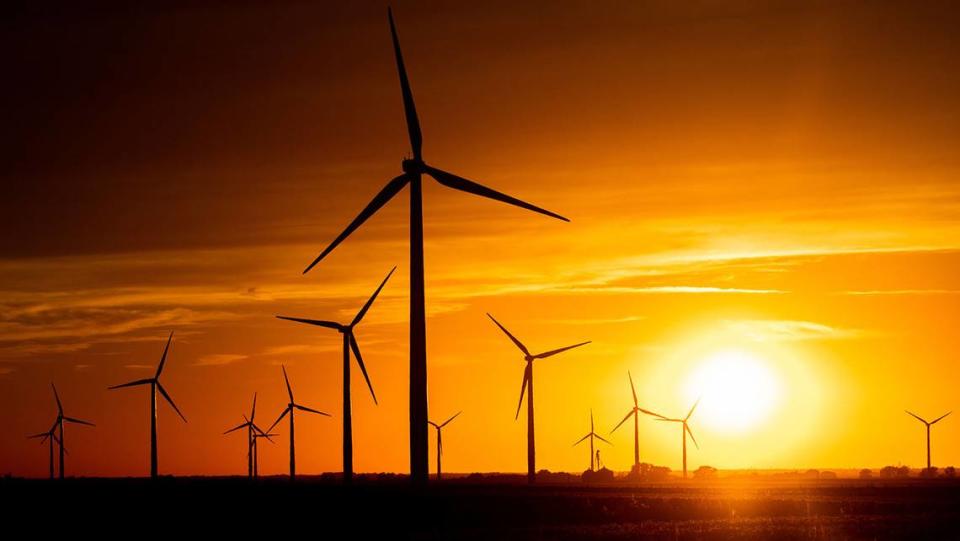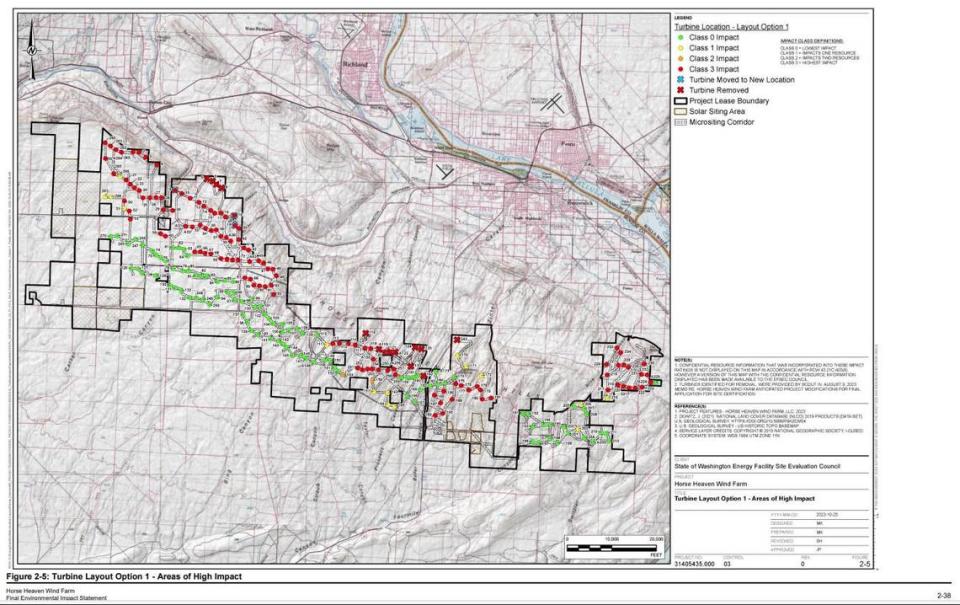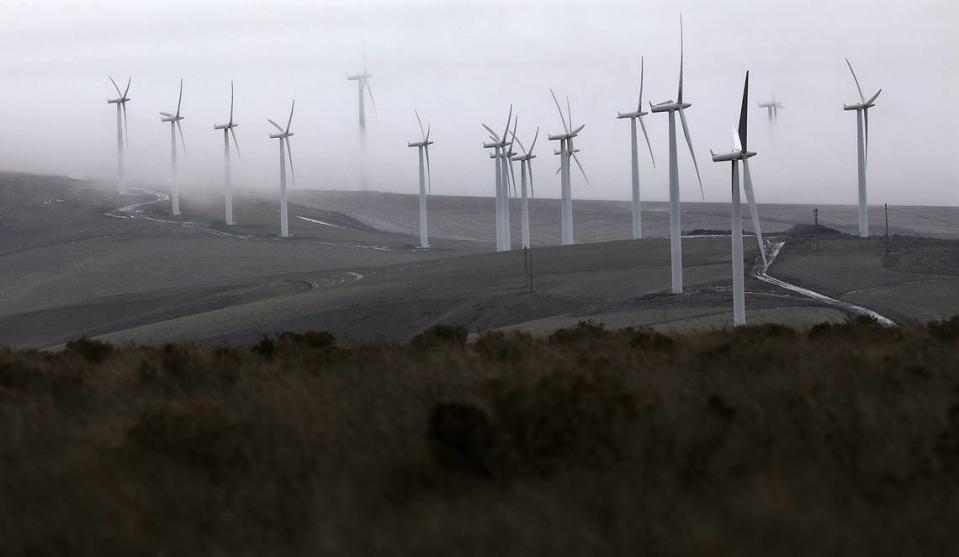‘Arbitrary, drastic’ restrictions could kill huge wind farm near Tri-Cities, says developer
Changes under consideration by a Washington state council for a huge wind farm just south of the Tri-Cities would make the project nonviable and could discourage other clean energy projects in the state, according to Scout Clean Energy.
The developer needs state approval for its Horse Heaven Clean Energy Center with up to 244 wind turbines up to 500 feet tall or another option with fewer but taller turbines. They would stretch over 24 miles along the Horse Heaven Hills from south of Finley to south of Kennewick to south of Benton City.
At the December meeting of the Washington state Energy Facility Site Evaluation Council (EFSEC), the council discussed possible restrictions on the project, including to protect tribal cultural resources and ferruginous hawks, an endangered species in Washington state with nests in the Horse Heaven Hills.
The restrictions could cut in half the number of wind turbines allowed, including eliminating many of those most visible from the Tri-Cities, and also restrict where solar panels, transmission lines and roads could be built.
The council further discussed the possibility of eliminating development proposed east of Straub Canyon south of Richland to protect tribal cultural resources.
A decision on whether to recommend restrictions to Washington Gov. Jay Inslee could be made as soon as the council’s meeting at 3 p.m. Wednesday, Jan. 31.
The changes proposed by EFSEC are “an arbitrary, drastic departure from established council precedents,” Scout Clean Energy said in comments to the council submitted Jan. 19 and recently, partially made public.
Eliminating the eastern half of the project, which is planned to be built first, would delay the project and mean that Scout Clean Energy could likely only buy the taller turbines that are becoming the industry norm, the developer said.
Critical grid interconnections also would be eliminated, it said.
“If feasible at all, these changes will necessitate a major redesign of the remaining project components and include the acquisition of additional land holdings to facilitate the movement of facilities and equipment,” Scout Clean Energy said.
Further delays “will add substantial, unanticipated costs and risks, rendering Scout’s substantial investments to date to develop the eliminated infrastructure unrecoverable,” the developer said.

Endangered hawks
The council’s proposal to require a two-mile buffer area around historically documented ferruginous hawk nests without no exceptions is far stricter than Oregon or Utah standards, Scout Clean Energy said.
The Oregon EFSEC recently approved a quarter-mile setback effective only for active nests and Utah recommends a half-mile buffer around nests that have been recently active, Scout Clean Energy said.
Roughly 16% of Washington’s Columbia Plateau is within two miles of a current or historic hawk nest, making that land also potentially off limits for energy development under the same restrictions, it said.
The historically documented nests in the 110 square miles of the Horse Heaven Hills project include nests going back to the 1970s, whether or not they exist today.
But nearly half of the documented nests are now gone or are just remnants of former nests, according to the developer. Some nests have been destroyed by wildfire or residential or commercial development, it said.
The last active ferruginous hawk nests within two miles of the project were documented in 2019, the developer said.
The decline of the ferruginous hawk statewide has been driven primarily by the loss of habitat for foraging due to agricultural use of land, Scout Clean Energy said.

Wildlife, tribal concerns
Scout Clean Energy also is questioning why eliminating development east of Straub Canyon as traditional cultural property is only coming up now after more than four years of coordination with the Washington state Department of Archaeology and Historic Preservation.
The state agency has not objected to developing east of the canyon, said the developer.
Scout Clean Energy also has coordinated with the Confederated Tribes of the Umatilla Indian Reservation, which it says traditionally held the lands and has treaty rights there. Scout has reached an agreement with the Umatillas on addressing any cultural resources there, it said.
Nothing in the public or confidential record for the project suggested there is reason to eliminate half the project area under the guise of protecting Yakama Nation, rather than Umatilla confederated tribes resources, said the developer.
Scout Clean Energy also is concerned that a 2013 model of wildlife movement that had no on-the-ground field review was used to restrict placement of infrastructure, including turbines, roads and power lines.
Scout biologists found that most of the linkage areas have been developed and used for agriculture and no longer provides viable routes for wildlife to move across the area.
Much of what Scout proposes, such as turbines and power lines, would not restrict wildlife, it said.
The proposed restriction is unprecedented and would have “grave consequences for the state’s renewable energy future,” Scout said.
If applied statewide, it would prohibit clean energy projects on more than 5,200 square miles.

Tri-Cities support, opposition
The Horse Heaven wind farm project, which also includes solar and battery storage, has the support of unions whose members would build the project.
Union officials have obtained a pledge that the contractor for the project would hire from Eastern and Central Washington unions, with an estimated 1,000 workers employed over the years of construction work. The project also would provide tax revenue to Benton County.
But it also has been met with significant opposition in the Tri-Cities, in part because it would industrialize the southern skyline in a community that prides itself on the colorful sunsets of its desert vistas.
Along with the nearby and smaller Nine Canyon wind farm, just over 100,000 residents of Benton County would live within six miles of a turbine, according to Tri-Cities CARES, a group opposing the wind farm as too close to the Tri-Cities.
That’s five times more than the estimated 20,000 who live within six miles of a wind farm across the rest of Washington state, according to the group.
There is also concern that the turbines would restrict firefighting by planes in an area prone to wildfires.
And the Benton PUD has issued a policy paper saying that the continued push for more wind projects by developers and many elected officials will do nothing to alleviate the looming risk of power grid blackouts in the Pacific Northwest.
Once Inslee receives the council’s recommendation on the Horse Heaven project he will have 60 days to approve the application with changes recommended by EFSEC, to reject it or to send the application back to the council for more work, according to EFSEC.
Audio of the Wednesday EFSEC meeting will be broadcast on tvw.org.

